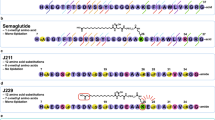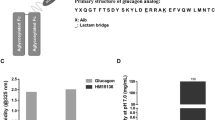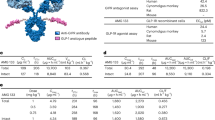Abstract
Glucagon-like peptide (GLP-1), a major physiological incretin, plays numerous important roles in modulating blood glucose homeostasis and has been proposed for the treatment of type 2 diabetes. The major obstacles for using native GLP-1 as a therapeutic agent are that it must be delivered by a parenteral route and has a short half-life. In an attempt to develop a strategy to prolong the physiological t1/2 and enhance the potency of GLP-1, a fusion protein consisting of active human GLP-1 and mouse IgG1 heavy chain constant regions (GLP-1/Fc) was generated. A plasmid encoding an IgK leader peptide-driven secretable fusion protein of the active GLP-1 and IgG1-Fc was constructed for mammalian expression. This plasmid allows for expression of bivalent GLP-1 peptide ligands as a result of IgG-Fc homodimerization. In vitro studies employing purified GLP-1/Fc indicate that the fusion protein is functional and elevates cAMP levels in insulin-secreting INS-1 cells. In addition, it stimulates insulin secretion in a glucose concentration-dependent manner. Intramuscular gene transfer of the plasmid in db/db mice demonstrated that expression of the GLP-1/Fc peptide normalizes glucose tolerance by enhancing insulin secretion and suppressing glucagon release. This strategy of using a bivalent GLP-1/Fc fusion protein as a therapeutic agent is a novel approach for the treatment of diabetes.
This is a preview of subscription content, access via your institution
Access options
Subscribe to this journal
Receive 12 print issues and online access
$259.00 per year
only $21.58 per issue
Buy this article
- Purchase on Springer Link
- Instant access to full article PDF
Prices may be subject to local taxes which are calculated during checkout








Similar content being viewed by others
References
Brubaker PL, Drucker DJ . Structure-function of the glucagon receptor family of G protein-coupled receptors: the glucagon, GIP, GLP-1, and GLP-2 receptors. Receptors Channels 2002; 8: 179–188.
Thorens B . Expression cloning of the pancreatic beta cell receptor for the gluco-incretin hormone glucagon-like peptide 1. Proc Natl Acad Sci USA 1992; 89: 8641–8645.
Bullock BP, Heller RS, Habener JF . Tissue distribution of messenger ribonucleic acid encoding the rat glucagon-like peptide-1 receptor. Endocrinology 1996; 137: 2968–2978.
Buteau J, Roduit R, Susini S, Prentki M . Glucagon-like peptide-1 promotes DNA synthesis, activates phosphatidylinositol 3-kinase and increases transcription factor pancreatic and duodenal homeobox gene 1 (PDX-1) DNA binding activity in beta (INS-1)-cells. Diabetologia 1999; 42: 856–864.
Montrose-Rafizadeh C, Avdonin P, Garant MJ, Rodgers BD, Kole S, Yang H et al. Pancreatic glucagon-like peptide-1 receptor couples to multiple G proteins and activates mitogen-activated protein kinase pathways in Chinese hamster ovary cells. Endocrinology 1999; 140: 1132–1140.
Wang Q, Brubaker PL . Glucagon-like peptide-1 treatment delays the onset of diabetes in 8 week-old db/db mice. Diabetologia 2002; 45: 1263–1273.
Wang Q, Li L, Xu E, Wong V, Rhodes C, Brubaker PL et al. Glucagon-like peptide-1 regulates proliferation and apoptosis via activation of protein kinase B in pancreatic INS-1 beta cells. Diabetologia 2004; 47: 478–487.
Buteau J, Foisy S, Rhodes CJ, Carpenter L, Biden TJ, Prentki M et al. Protein kinase Czeta activation mediates glucagon-like peptide-1-induced pancreatic beta-cell proliferation. Diabetes 2001; 50: 2237–2243.
Nauck MA . Glucagon-like peptide 1 (GLP-1) in the treatment of diabetes. Horm Metab Res 2004; 36: 852–858.
Ritzel R, Schulte M, Porksen N, Nauck MS, Holst JJ, Juhl C et al. Glucagon-like peptide 1 increases secretory burst mass of pulsatile insulin secretion in patients with type 2 diabetes and impaired glucose tolerance. Diabetes 2001; 50: 776–784.
Ritzel R, Orskov C, Holst JJ, Nauck MA . Pharmacokinetic, insulinotropic, and glucagonostatic properties of GLP-1 (7–36 amide) after subcutaneous injection in healthy volunteers. Dose-response-relationships. Diabetologia 1995; 38: 720–725.
Willms B, Werner J, Holst JJ, Orskov C, Creutzfeldt W, Nauck MA et al. Gastric emptying, glucose responses, and insulin secretion after a liquid test meal: effects of exogenous glucagon-like peptide-1 (GLP-1)-(7–36) amide in type 2 (noninsulin-dependent) diabetic patients. J Clin Endocrinol Metab 1996; 81: 327–332.
Vella A, Shah P, Basu R, Basu A, Holst JJ, Rizza RA et al. Effect of glucagon-like peptide 1(7–36) amide on glucose effectiveness and insulin action in people with type 2 diabetes. Diabetes 2000; 49: 611–617.
Conarello SL, Li Z, Ronan J, Roy RS, Zhu L, Jiang G et al. Mice lacking dipeptidyl peptidase IV are protected against obesity and insulin resistance. Proc Natl Acad Sci USA 2003; 100: 6825–6830.
Egan JM, Meneilly GS, Habener JF, Elahi D . Glucagon-like peptide-1 augments insulin-mediated glucose uptake in the obese state. J Clin Endocrinol Metab 2002; 87: 3768–3773.
Miyawaki K, Yamada Y, Yano H, Niwa H, Ban N, Ihara Y et al. Glucose intolerance caused by a defect in the entero-insular axis: a study in gastric inhibitory polypeptide receptor knockout mice. Proc Natl Acad Sci USA 1999; 96: 14843–14847.
Holz GG, Kuhtreiber WM, Habener JF . Pancreatic beta-cells are rendered glucose-competent by the insulinotropic hormone glucagon-like peptide-1(7–37). Nature 1993; 361: 362–365.
Xu G, Stoffers DA, Habener JF, Bonner-Weir S . Exendin-4 stimulates both beta-cell replication and neogenesis, resulting in increased beta-cell mass and improved glucose tolerance in diabetic rats. Diabetes 1999; 48: 2270–2276.
Tourrel C, Bailbe D, Lacorne M, Meile MJ, Kergoat M, Portha B et al. Persistent improvement of type 2 diabetes in the Goto-Kakizaki rat model by expansion of the beta-cell mass during the prediabetic period with glucagon-like peptide-1 or exendin-4. Diabetes 2002; 51: 1443–1452.
Bouckenooghe T, Vandewalle B, Lukowiak B, Kerr-Conte J, Belaich S, Gmyr V et al. Modulation of specific beta cell gene (re)expression during in vitro expansion of human pancreatic islet cells. Cell Transplant 2003; 12: 799–807.
Flint A, Raben A, Astrup A, Holst JJ . Glucagon-like peptide 1 promotes satiety and suppresses energy intake in humans. J Clin Invest 1998; 101: 515–520.
Kieffer TJ, McIntosh CH, Pederson RA . Degradation of glucose-dependent insulinotropic polypeptide and truncated glucagon-like peptide 1 in vitro and in vivo by dipeptidyl peptidase IV. Endocrinology 1995; 136: 3585–3596.
Mentlein R, Gallwitz B, Schmidt WE . Dipeptidyl-peptidase IV hydrolyses gastric inhibitory polypeptide, glucagon-like peptide-1(7–36)amide, peptide histidine methionine and is responsible for their degradation in human serum. Eur J Biochem 1993; 214: 829–835.
Montrose-Rafizadeh C, Avdonin P, Garant MJ, Rodgers BD, Kole S, Yang H et al. Pancreatic glucagon-like peptide-1 receptor couples to multiple G proteins and activates mitogen-activated protein kinase pathways in Chinese hamster ovary cells. Endocrinology 1999; 140: 1132–1140.
Ahren B, Schmitz O . GLP-1 receptor agonists and DPP-4 inhibitors in the treatment of type 2 diabetes. Horm Metab Res 2004; 36: 867–876.
Green BD, Gault VA, O’harte FP, Flatt PR . Structurally modified analogues of glucagon-like peptide-1 (GLP-1) and glucose-dependent insulinotropic polypeptide (GIP) as future antidiabetic agents. Curr Pharm Des 2004; 10: 3651–3662.
Chang AM, Jakobsen G, Sturis J, Smith MJ, Bloem CJ, An B et al. The GLP-1 derivative NN2211 restores beta-cell sensitivity to glucose in type 2 diabetic patients after a single dose. Diabetes 52; 2003: 1786–1791.
Liu HK, Green BD, Gault VA, McCluskey JT, McClenaghan NH, O’Harte FP et al. N-acetyl-GLP-1: a DPP IV-resistant analogue of glucagon-like peptide-1 (GLP-1) with improved effects on pancreatic beta-cell-associated gene expression. Cell Biol Int 2004; 28: 69–73.
Fineman MS, Bicsak TA, Shen LZ, Taylor K, Gaines E, Varns A et al. Effect on glycemic control of exenatide (synthetic exendin-4) additive to existing metformin and/or sulfonylurea treatment in patients with type 2 diabetes. Diabet Care 2003; 26: 2370–2377.
Kim JG, Baggio LL, Bridon DP, Castaigne JP, Robitaille MF, Jette L et al. Development and characterization of a glucagon-like peptide 1-albumin conjugate: the ability to activate the glucagon-like peptide 1 receptor in vivo. Diabetes 2003; 52: 751–759.
Weir AN, Nesbitt A, Chapman AP, Popplewell AG, Antoniw P, Lawson AD et al. Formatting antibody fragments to mediate specific therapeutic functions. Biochem Soc Trans 2002; 30: 512–516.
Goldenberg MM . Etanercept, a novel drug for the treatment of patients with severe, active rheumatoid arthritis. Clin Ther 1999; 21: 75–87.
Reimold AM . TNFalpha as therapeutic target: new drugs, more applications. Curr Drug Targets Inflamm Allergy 2002; 1: 377–392.
George SR, O’Dowd BF, Lee SP . G-protein-coupled receptor oligomerization and its potential for drug discovery. Nat Rev Drug Discov 2002; 1: 808–820.
Dupuis DS, Perez M, Halazy S, Colpaert FC, Pauwels PJ . Magnitude of 5-HT1B and 5-HT1A receptor activation in guinea-pig and rat brain: evidence from sumatriptan dimer-mediated [35S]GTPgammaS binding responses. Brain Res Mol Brain Res 1999; 67: 107–123.
Hartikka J, Sawdey M, Cornefert-Jensen F, Margalith M, Barnhart K, Nolasco M et al. An improved plasmid DNA expression vector for direct injection into skeletal muscle. Hum Gene Ther 1996; 20: 1205–1217.
Lawson BR, Prud’homme GJ, Chang Y, Gardner HA, Kuan J, Kono DH et al. Treatment of murine lupus with cDNA encoding IFN-gammaR/Fc. J Clin Invest 2000; 106: 207–215.
Prud’homme GJ, Chang Y . Prevention of autoimmune diabetes by intramuscular gene therapy with a nonviral vector encoding an interferon-gamma receptor/IgG1 fusion protein. Gene Therapy 1999; 6: 771–777.
Ozmen L, Gribaudo G, Fountoulakis M, Gentz R, Landolfo S, Garotta G et al. Mouse soluble IFN gamma receptor as IFN gamma inhibitor. Distribution, antigenicity, and activity after injection in mice. J Immunol 1993; 150: 2698–2705.
Kurschner C, Ozmen L, Garotta G, Dembic Z . IFN-gamma receptor-Ig fusion proteins. Half-life, immunogenicity, and in vivo activity. J Immunol 1992; 149: 4096–4100.
Kurschner C, Garotta G, Dembic Z . Construction, purification, and characterization of new interferon gamma (IFN gamma) inhibitor proteins. Three IFN gamma receptor-immunoglobulin hybrid molecules. J Biol Chem 1992; 267: 9354–9360.
Jungbauer A, Tauer C, Reiter M, Purtscher M, Wenisch E, Steindl F et al. Comparison of protein A, protein G and copolymerized hydroxyapatite for the purification of human monoclonal antibodies. J Chromatogr 1989; 476: 257–268.
Baggio L, Kieffer TJ, Drucker DJ . Glucagon-like peptide-1, but not glucose-dependent insulinotropic peptide, regulates fasting glycemia and nonenteral glucose clearance in mice. Endocrinology 2000; 141: 3703–3709.
Drucker DJ . Glucagon-like peptides. Diabetes 1998; 47: 159–169.
Green BD, Gault VA, Mooney MH, Irwin N, Bailey CJ, Harriott P et al. Novel dipeptidyl peptidase IV resistant analogues of glucagon-like peptide-1(7–36)amide have preserved biological activities in vitro conferring improved glucose-lowering action in vivo. J Mol Endocrinol 2003; 31: 529–540.
Larsen PJ, Fledelius C, Knudsen LB, Tang-Christensen M . Systemic administration of the long-acting GLP-1 derivative NN2211 induces lasting and reversible weight loss in both normal and obese rats. Diabetes 2001; 50: 2530–2539.
Rolin B, Larsen MO, Gotfredsen CF, Deacon CF, Carr RD, Wilken M et al. The long-acting GLP-1 derivative NN2211 ameliorates glycemia and increases beta-cell mass in diabetic mice. Am J Physiol Endocrinol Metab 2002; 283: E745–E752.
Larrick JW, Fry KE . Recombinant antibodies. Hum Antibodies Hybridomas 1991; 2: 172–189.
Hupe-Sodmann K, McGregor GP, Bridenbaugh R, Göke R, Göke B, Thole H et al. Characterisation of the processing by human neutral endopeptidase 24.11 of GLP-1(7–36) amide and comparison of the substrate specificity of the enzyme for other glucagon-like peptides. Regul Pept 1995; 58: 149–156.
Fountoulakis M, Mesa C, Schmid G, Gentz R, Manneberg M, Zulauf M et al. Interferon gamma receptor extracellular domain expressed as IgG fusion protein in Chinese hamster ovary cells. Purification, biochemical characterization, and stoichiometry of binding. J Biol Chem 1995; 270: 3958–3964.
Herberg L, Coleman DL . Laboratory animals exhibiting obesity and diabetes syndromes. Metabolism 1977; 26: 59–99.
Chen H, Charlat O, Tartaglia LA, Woolf EA, Weng X, Ellis SJ et al. Evidence that the diabetes gene encodes the leptin receptor: identification of a mutation in the leptin receptor gene in db/db mice. Cell 1996; 84: 491–495.
McIntosh CHS, Pederson RA . Nonisnulin-dependent animal models of diabetes mellitus. In: McNeill JH (ed). Experimental Models of Diabetes. CRC Press: Boca Raton, FL, 1999, pp 337–398.
Turton MD, O’Shea D, Gunn I, Beak SA, Edwards CM, Meeran K et al. A role for glucagon-like peptide-1 in the central regulation of feeding. Nature 1996; 379: 69–72.
Weyer C, Bogardus C, Pratley RE . Metabolic characteristics of individuals with impaired fasting glucose and/or impaired glucose tolerance. Diabetes 1999; 48: 2197–2203.
Turner RC, Cull CA, Frighi V, Holman RR . Glycemic control with diet, sulfonylurea, metformin, or insulin in patients with type 2 diabetes mellitus: progressive requirement for multiple therapies (UKPDS 49). UK Prospective Diabetes Study (UKPDS) Group. JAMA 1999; 281: 2005–2012.
Schick RR, Zimmermann JP, vorm WT, Schusdziarra V . Peptides that regulate food intake: glucagon-like peptide 1-(7–36) amide acts at lateral and medial hypothalamic sites to suppress feeding in rats. Am J Physiol Regul Integr Comp Physiol 2003; 284: R1427–R1435.
Lee AY, Chey WY, Choi J, Jeon JS . Insulin-induced drug eruptions and reliability of skin tests. Acta Derm Venereol 2002; 82: 114–117.
Ahangari G, Ostadali MR, Rabani A, Rashidian J, Sanati MH, Zarindast MR et al. Growth hormone antibodies formation in patients treated with recombinant human growth hormone. Int J Immunopathol Pharmacol 2004; 17: 33–38.
King LB, Monroe JG . Immunobiology of the immature B cell: plasticity in the B-cell antigen receptor-induced response fine tunes negative selection. Immunol Rev 2000; 176: 86–104.
Ravetch JV, Bolland S . IgG Fc receptors. Annu Rev Immunol 2001; 19: 275–290.
Takai T . Fc receptors and their role in immune regulation and autoimmunity. J Clin Immunol 2005; 25: 1–18.
Prud’homme GJ . Altering immune tolerance therapeutically: the power of negative thinking. J Leukoc Biol 2004; 75: 586–599.
Melo MEF, Qian F, El-Amine M, Agarwal RK, Soukhareva N, Kang Y et al. Gene transfer of Ig-fusion proteins into B cells prevents and treats autoimmune diseases. J Immunol 2002; 168: 4788–4795.
Prinz WA, Aslund F, Holmgren A, Beckwith J . The role of the thioredoxin and glutaredoxin pathways in reducing protein disulfide bonds in the Escherichia coli cytoplasm. J Biol Chem 1997; 20: 15661–15667.
Kurland C, Gallant J . Errors of heterologous protein expression. Curr Opin Biotechnol 1996; 7: 489–493.
Acknowledgements
This work was supported by grants from the Canadian Institute for Health Research (CIHR, to Q Wang) and the Juvenile Diabetes Research Foundation (JDRF, PI: Q Wang; Co-PI: G Prud’homme). Q Wang is a recipient of a Canadian Diabetes Association Scholarship. M Kumar is a recipient of the Canadian Diabetes Association Fellowship. The authors are grateful to Dr P Doherty (St Michael's Hospital, Toronto, Canada) for critical reading of the manuscript.
Author information
Authors and Affiliations
Corresponding author
Rights and permissions
About this article
Cite this article
Kumar, M., Hunag, Y., Glinka, Y. et al. Gene therapy of diabetes using a novel GLP-1/IgG1-Fc fusion construct normalizes glucose levels in db/db mice. Gene Ther 14, 162–172 (2007). https://doi.org/10.1038/sj.gt.3302836
Received:
Revised:
Accepted:
Published:
Issue Date:
DOI: https://doi.org/10.1038/sj.gt.3302836
Keywords
This article is cited by
-
A micro-nano optogenetic system based on probiotics for in situ host metabolism regulation
Nano Research (2023)
-
Adeno-associated virus-mediated expression of myostatin propeptide improves the growth of skeletal muscle and attenuates hyperglycemia in db/db mice
Gene Therapy (2017)
-
Long-term, antidiabetogenic effects of GLP-1 gene therapy using a double-stranded, adeno-associated viral vector
Gene Therapy (2011)
-
Effective and safe gene-based delivery of GLP-1 using chitosan/plasmid-DNA therapeutic nanocomplexes in an animal model of type 2 diabetes
Gene Therapy (2011)
-
DsAAV8-mediated expression of glucagon-like peptide-1 in pancreatic beta-cells ameliorates streptozotocin-induced diabetes
Gene Therapy (2010)



